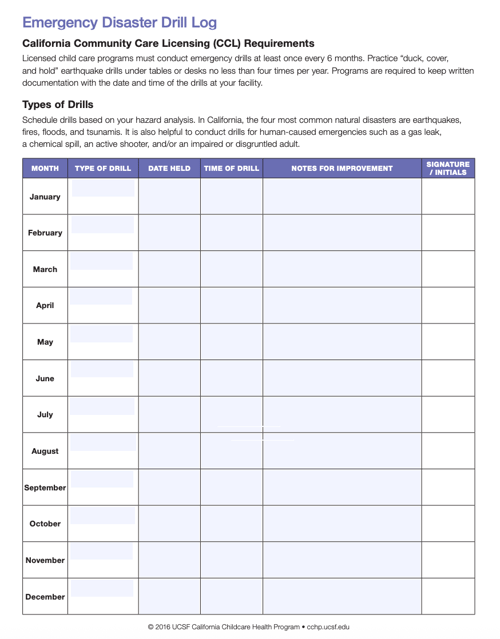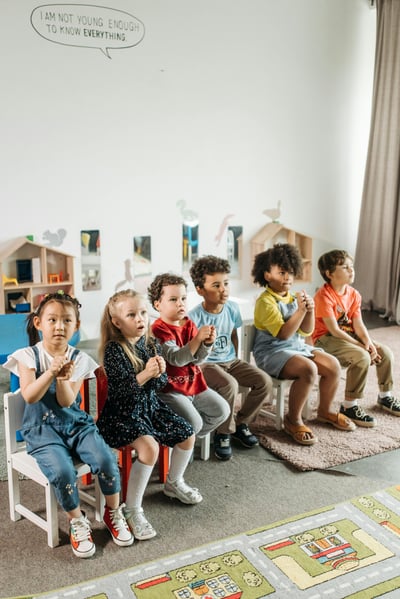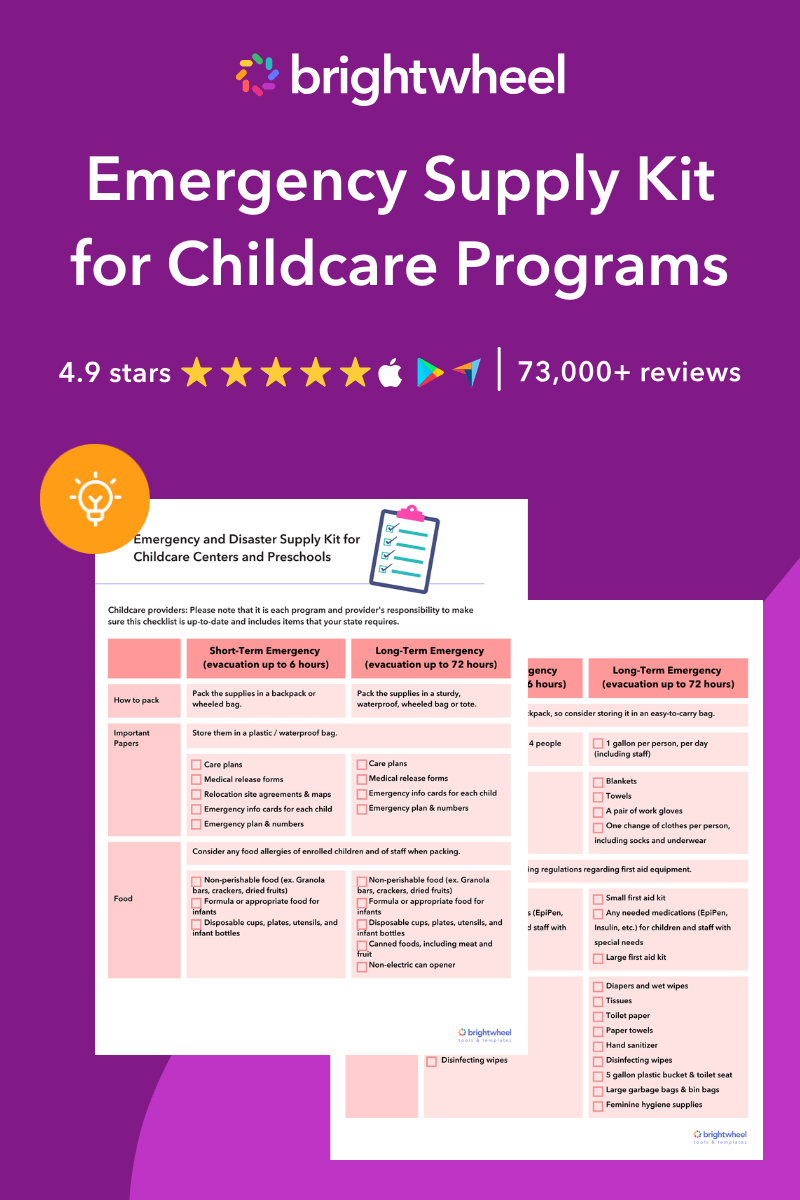In a busy preschool setting, where children are constantly exploring, learning, and growing, having preschool emergency procedures in place is essential. These procedures safeguard the well-being of children and staff during unexpected situations—whether natural disasters, medical incidents, or security threats. A comprehensive emergency response plan not only prevents chaos and confusion in a crisis but also fosters confidence and peace of mind for parents, caregivers, and educators.
In this article, we highlight the importance of implementing effective preschool emergency procedures and provide guidance on conducting drills to ensure preparedness.
What is an emergency preparedness plan?
An emergency preparedness plan is a step-by-step guide to ensure that everyone in your childcare program, including children and staff, are safe before, during, and after an emergency. Creating this plan can help providers address and reduce health and safety risks before they happen. An emergency preparedness plan can be one part of your program's larger risk management plan to help you protect your business and minimize potential risks related to emergency situations.
Emergency Supply Kit
Download this free quick reference guide and templates to prepare your childcare program for an emergency.
Most childcare programs across the country are required to obtain licensing based on requirements set by their state childcare divisions. These provisions often state that programs must develop, implement, and maintain written policies and procedures for responding to emergencies.
When creating preschool emergency procedures, consider the following factors before outlining your plan:
- The age of the children
- The physical and mental abilities of the children
- Whether your program provides care for non-ambulatory children
- The types of disasters or emergencies likely to affect your area
- The requirements of your local fire and safety departments
Use this information to guide you as you create the following two suggested emergency plan components:
Responsible parties
It’s important that your emergency plan identifies the staff members responsible for implementing the plan and ensuring the safety of the children. Examples of how to include responsible parties in your emergency plan are to decide who will:
- Place emergency calls to the police and fire departments
- Make emergency announcements to warn other building occupants and summon staff
- Account for children and ensure no one leaves a room or designated safe area
- Lead relocation of children during evacuations, including children with special needs
- Contact families and notify them of plans to assist with reunification
Policies and procedures
The written plan will also provide a step-by-step guide that details actions to be taken in the case of medical and non-medical emergencies, evacuations, and lock-down procedures.
Medical and non-medical emergencies are situations that could pose a threat to your children and staff. These situations include fire, carbon monoxide exposure, bomb threats, missing children, or environmental emergencies like a tornado or flood. Evacuations are often conducted if a disaster or emergency could cause damage to the facility or endanger the people inside. Lock-down procedures need to be determined for situations that may harm the people inside the building such as an active shooter, hostage incident, or trespassing.
Your policies and procedures can also include collaborative planning details with other groups, access to emergency information, and your plans for conducting emergency drills. A tool like brightwheel’s incident report feature enables you to easily log incidents, send emergency alerts, and gives you easy access to child and staff records including emergency contact and health information.




Why preschool emergency procedures matter
Planning for emergencies is especially important for any childcare provider because you’re responsible for your children’s safety and well-being. Proper health and safety training for childcare providers is a great place to start, but your preschool also needs specific action plans for health, safety, and environmental issues. Preschool emergency procedures are necessary to protect you, your staff, and your children from harm. It also develops an overall culture and environment of safety, minimizes class disruption, and ensures a quicker recovery after incidents.
Creates a safe environment
Once you create emergency plans for different situations, document them and clearly communicate them to your staff, children, and families. When everyone at your program understands the plans for an emergency, it creates an environment where everyone is prepared to act and play their part. Also, having the right supplies and items contributes to that environment because your program will have everything you might need to handle an emergency.
Minimizes risks
There’s no way to ensure your preschool never experiences an emergency, but being prepared is the only way to mitigate overall risk. For example, part of your emergency preparedness plan could be ensuring staff always have immediate access to an EpiPen for children with allergies, including during outside play or field trips. So, in the case of accidental allergen exposure, being prepared decreases any risk of the child experiencing a reaction without access to their EpiPen.
Ensures quicker recovery after incidents
A thorough emergency preparedness plan includes what to do in case of an incident and what to do once it has been resolved. Some situations will require all children to be picked up or all staff to go home; others will allow the rest of the day to resume as normal. Having a clear plan for what needs to happen post-emergency helps make the process smoother and faster.
Emergency action plan template
As you create your preschool’s emergency action plan, include how to be prepared before an emergency, how to act safely during an emergency, and what to do after an emergency. Outline procedures for staff to take care of their class and simple directions for the children. Also, add any relevant policies and emergency contact forms for each child to ensure you can contact their family as quickly as possible during an incident.
You can also reference a template that features common elements of an emergency action plan to inspire you to think of everything you may need to include in yours. You can personalize one to fit your preschool’s needs and make changes depending on things like how many staff members are available, which children are in your care, and where exits are located. Review the following templates as you create your own emergency action plan.
National Center on Early Childhood Health and Wellness
The Emergency Preparedness Manual for Early Childhood Programs, published by the National Center on Early Childhood Health and Wellness, offers helpful information on emergency preparedness, response, and recovery, and many useful templates as you build your emergency action plan.
Centers for Disease Control and Prevention (CDC)
While this example wasn’t created exclusively for childcare centers, the CDC has created an Emergency Action Plan Template that can suit any facility. The sample forms in this template include:
- Emergency personnel contact information forms
- Local department contact information for police, fire department, paramedics, and ambulance
- Utility company emergency contacts (e.g. electric, water, gas, and telephone)
- Emergency reporting and evacuation procedures
To ensure you’re adding safety measures to your policies and procedures, the CDC’s Emergency Action Plan template features step-by-step measures you can take in the event of an emergency. The emergencies this template covers include a medical emergency, fire emergency, extended power loss, chemical spill, and severe weather and natural disasters.
UCSF California Childcare Health Program
The UCSF California Childcare Health Program created the Emergency Plan Library, an extensive resource of forms and templates for building an emergency action plan. It includes a child emergency information form, a damage assessment tool, and an emergency disaster drill log.
The emergency disaster drill log below prompts the user to state the type of drill and the date and time it took place. Additionally, it leaves notes for improvement to be provided by the administrator of the drill. The Emergency Plan Library stresses the importance of drills by providing samples of drill procedures for earthquakes, fires, floods, lockdowns, and shelter-in-place emergencies.

How to practice a preschool emergency drill
After spending the time to create an emergency plan, you’ll need to provide training to children and staff to make sure that everyone knows what to do in the event of an emergency. Emergency drills are practice situations that help increase the preparedness of the staff and children at your program. It can confirm whether your plan is reliable and reveal any areas for improvement. Use the information below to help you practice emergency drills at your school.
Teach your children about emergencies
To practice emergency drills with the children in your preschool or daycare, they must understand what an emergency is. Teach them about medical and non-medical emergencies. Teach them about environmental emergencies like earthquakes, hurricanes, and floods. As you help your children prepare, describe what they’ll see, hear, and experience. Explain that while the drill might have slightly different conditions, the plan is to treat it like it’s real.
You can also use this time to tell them what not to do during an emergency like pushing, shouting, or talking to other children. Walk them through how long drills typically take with a reminder that they’re only temporary.
Use examples
It might be challenging for a child to grasp the concept of emergencies through words. Use examples or stories to illustrate them. For example, you can use the spaghetti tornado scene from the animated film Cloudy with a Chance of Meatballs. It’s a child-friendly way to introduce an emergency like tornadoes. The film also creates the opportunity to demonstrate and discuss what not to do.
Stay calm and positive
Children are more in tune with people’s emotions than adults typically give them credit for. They can sense stress and anxiety through tone and attitude. During the drill, speak calmly and stay positive. This will help them understand your instructions and stay calm.
Practice regularly
Most states require childcare programs to conduct emergency drills every three months or twice a year. This ensures that the procedure is easily recalled by staff and children. As you practice your drill, consider these five components:
- Notification: Tell the children that a drill is about to happen and to listen for any identifying noise that will prompt the start of the drill. Explain the actions that you’ll take during the drill.
- Action: Execute the actions in your emergency plan. This might include evacuating the building, collecting the appropriate documents or disaster supplies, or taking attendance of the children.
- Communication: Role play and practice how you’ll communicate with outside parties. In emergencies, you might need to use a portable battery or hand-assisted radio to listen to announcements or turn your cell phone on silent or vibrate. You can also role play how you would provide status updates to families or call 911.
- Care and supervision: Follow your established procedures for the care and supervision of the children. This includes procedures to help children stay quiet, assisting children or staff with special health care needs, and addressing children’s nutrition and hygiene needs.
- Conclusion: Remain in your emergency drill conditions until the childcare director or designee announces the end of the drill.
Frequently asked questions about preschool emergency procedures
What are preschool emergency procedures?
Preschool emergency procedures are step-by-step plans that guide staff and children on how to respond during crises such as fires, medical emergencies, lockdowns, or natural disasters. These procedures help ensure safety, reduce confusion, and provide clear roles and responsibilities for teachers and caregivers.
Why are preschool emergency procedures important?
Emergencies can happen at any time. Having clear preschool emergency procedures minimizes risk, protects children, and ensures staff can act quickly and confidently. A well-practiced plan also reassures parents that their children are in a safe and prepared environment.
How often should emergency drills be conducted in preschools?
Most experts recommend monthly fire drills, quarterly lockdown or shelter-in-place drills, and at least one comprehensive annual drill that covers multiple scenarios. Frequent practice helps children and staff build familiarity and respond calmly in real emergencies.
How can teachers prepare children for emergency procedures without causing fear?
Teachers can use age-appropriate language, practice drills in a calm and reassuring manner, and frame drills as “safety practice” rather than something scary. Visual aids, songs, and role-playing can also help children understand routines in a positive way.
Improve your safety
You can never be too prepared in the face of an emergency. Preschool emergency procedures are an irreplaceable tool for childcare programs that help ensure the safety of children and staff. Taking the steps to create thorough procedures will help you prepare for a crisis, respond to the event, and recover in the aftermath of a real emergency.



